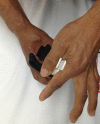Variable innervation of the first dorsal interosseous muscle: an electrophysiological study
- PMID: 33437762
- PMCID: PMC7791233
- DOI: 10.21037/atm-20-1466
Variable innervation of the first dorsal interosseous muscle: an electrophysiological study
Abstract
Background: The first dorsal interosseous muscle (FDI) is usually innervated by the deep branch of the ulnar nerve. However, as was first noted by Sunderland in 1946, some individuals have variable innervation of the FDI. This study investigated the incidence of variable innervation of the FDI by using electrophysiological examination and further evaluated the relevance of this variation in patients with cubital tunnel syndrome (CuTS).
Methods: This study included 211 patients who underwent peripheral nerve surgery in Huashan hospital, Fudan University, between October, 2012 and February, 2014. The patients were divided into three groups: the carpal tunnel syndrome (CTS) group, the CuTS group and the control group. During surgery, electromyography was used to determine FDI variation, and a hand function instrument was employed to estimate the pinch strength between the thumb and index finger in both hands of the CuTS patients.
Results: The electromyogram test showed that 22 of the patients enrolled had variable innervation of the FDI. Compared with the CTS group and the control group, the incidence of variable innervation of the FDI was much higher in the CuTS group (P<0.05). Patients under the age of 60 years old in the CuTS group were more likely to have the variation (P=0.043). A higher pinch strength ratio was significantly associated with variable innervation of the FDI in the CuTS patients (P=0.030).
Conclusions: Using electromyography, our study demonstrated that the variable innervation of the FDI could be innervated by the median nerve. In the CuTS patients, the higher incidence of FDI variation was possibly related to age. This variation might lead to a better prognosis for CuTS patients.
Keywords: First dorsal interosseous muscle (FDI); median nerve; ulnar nerve; variable innervation.
2020 Annals of Translational Medicine. All rights reserved.
Conflict of interest statement
Conflicts of Interest: All authors have completed the ICMJE uniform disclosure form (available at http://dx.doi.org/10.21037/atm-20-1466). The authors have no conflicts of interest to declare.
Figures



Similar articles
-
Transferring the Motor Branch of the Opponens Pollicis to the Terminal Division of the Deep Branch of the Ulnar Nerve for Pinch Reconstruction.J Hand Surg Am. 2019 Jan;44(1):9-17. doi: 10.1016/j.jhsa.2018.09.010. Epub 2018 Oct 23. J Hand Surg Am. 2019. PMID: 30366737
-
Innervation and vascular supply of the first dorsal interosseous muscle and palmar interosseous muscle of the index: An anatomic descriptive study.Morphologie. 2021 Dec;105(351):298-307. doi: 10.1016/j.morpho.2020.12.008. Epub 2021 Jan 19. Morphologie. 2021. PMID: 33483184
-
An assessment of Martin-Gruber anastomosis discrepancies between healthy individuals and patients with carpal tunnel syndrome in motor nerve conduction studies.Curr J Neurol. 2023 Jul 6;22(3):179-187. doi: 10.18502/cjn.v22i3.13798. Curr J Neurol. 2023. PMID: 38011374 Free PMC article.
-
[Clinical and electrophysiological findings in carpal tunnel syndrome].Brain Nerve. 2007 Nov;59(11):1229-38. Brain Nerve. 2007. PMID: 18044199 Review. Japanese.
-
Cubital tunnel syndrome - a review and management guidelines.Cent Eur Neurosurg. 2011 May;72(2):90-8. doi: 10.1055/s-0031-1271800. Epub 2011 May 4. Cent Eur Neurosurg. 2011. PMID: 21547883 Review.
Cited by
-
Fast and Accurate EEG/MEG BEM-Based Forward Problem Solution for High-Resolution Head Models.bioRxiv [Preprint]. 2024 Jun 8:2024.06.07.598024. doi: 10.1101/2024.06.07.598024. bioRxiv. 2024. Update in: Neuroimage. 2025 Feb 01;306:120998. doi: 10.1016/j.neuroimage.2024.120998. PMID: 38895215 Free PMC article. Updated. Preprint.
-
Fast EEG/MEG BEM-based forward problem solution for high-resolution head models.Neuroimage. 2025 Feb 1;306:120998. doi: 10.1016/j.neuroimage.2024.120998. Epub 2025 Jan 1. Neuroimage. 2025. PMID: 39753164 Free PMC article.
References
-
- Li QT, Tian GL. The Diagnostics of Hand Surgery. The People’s Medical Publishing House 2009:110-2.
-
- Gu YD. Some related questions in the diagnosis and treatment of the carpal tunnel syndrome and cubital tunnel syndrome Chin J Hand Surg 2010;26:321-3.
LinkOut - more resources
Full Text Sources
Research Materials
